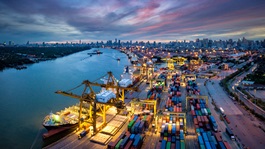Publication
Distress signals: Cooperation agreements or mergers to the rescue in times of crisis?
The current volatile and unpredictable economic climate creates challenges for businesses.


Author:
Australia | Publication | October 2020
After substantial delay from its usual May release, Treasurer Josh Frydenberg announced yesterday (6 October, 2020) the Federal Government budget for FY2020-21 (Budget). One of the key focuses of this budget is an infrastructure-led economic recovery from the COVID-19 pandemic, which is particularly favourable for those whose employment, business, or other interests align with those of the infrastructure sector.
The Budget further advances the approach taken to date by the Federal Government by encouraging spending on infrastructure projects in the hope of creating jobs and boosting productivity and, in turn, the economy, whilst reducing the timeframes for approvals for major projects. Notably, since the start of the pandemic, $14 billion in ‘new spending’ has been allocated to new and fast-tracked infrastructure projects over the next 4 years.
The emergence of COVID-19, and social distancing restrictions implemented to combat it, have led to precipitous drops in utilisation of transport assets. Air travel has almost entirely ceased across Australia, resulting in QANTAS being forced to engage in lay-offs and Virgin entering, and emerging from, insolvency. In most major cities, public transport patronage has shrunk to a fraction of its normal levels, despite many States lifting lockdown restrictions – a severe example being Melbourne which has seen a drop of 90% in public transport use. Traffic volumes, which reduced by up to 88% in some cities during the first wave, have begun to recover. Unsurprisingly, we have seen an upturn in modes of active transportation such as walking and cycling, to which state and local governments have reacted by introducing additional cycling lanes and incentives to shop locally.
Transport is the clear 'winner' as the Budget reveals strong Federal Government support for new transport infrastructure building on its 10-year transport infrastructure pipeline, which has been expanded to $110 billion. The States will also receive additional funding in “use-it-or-lose-it” payments to get fast-tracked projects going, in particular road upgrade projects. This is in line with the Federal Government’s previously announced commitment to smaller ‘shovel-ready’ projects. Consistent with the focus on encouraging decentralisation and growth in rural areas, a large part of the funding has been allocated towards projects outside of the major cities. This includes over $500 million for regional rail upgrades in Victoria, regional highway upgrades and faster rail planning in New South Wales, and rural highway upgrades for regional communities in other states.
Other notable allocations include:
Social infrastructure’s COVID-19 report card demonstrates mixed results: some social infrastructure (such as public venues, arts and cultural assets, office and retail assets) have faced underutilisation during tough social distancing restrictions. This underutilisation has continued even after the easing of restrictions in some States due to the normalisation of remote working arrangements. Healthcare assets (such as hospitals, equipment and labour) have naturally been big ‘winners’, with concerns over the healthcare system’s ability to deal with the pandemic leading to large investments aimed at increasing capacity.
The Budget provides little in the way of specific announcements in respect of funding for social infrastructure projects. This is unsurprising given healthcare, a large component of the social infrastructure sector, is predominantly a state-managed sector. At the state level, several commitments have been made which are likely to attract some federal funding – for example, Victoria’s $1.5 billion new Footscray Hospital, $562 million redevelopment of the Frankston Hospital and $1 billion Social Housing Growth Fund, Queensland’s Logan Hospital Expansion and New South Wales’ new Bankstown-Lidscombe Hospital.
As part of the Perth City Deal, $327.5 million over 11 years will see improvements made in cycling and walking infrastructure along with the relocation of Edith Cowan University’s campus to the CBD. Regional communities will also see a $100 million investment in tourism-related infrastructure projects to boost regional tourism.
COVID-19 has had mixed impacts on supply chain infrastructure. A sustained contraction in global trade and demand for Australian exports has led to substantially diminished utilisation of air and sea ports. Major port operators, such as the Brisbane Airport and the Port of Melbourne expect freight volumes to remain suppressed for some time, leading to a number of domestic and international operators to shore up their balance sheets with bond or other capital raisings. Local manufacturing capacity and domestic logistics, on the other hand, have experienced expanded utilisation due to increased demand for locally manufactured essential goods like hand sanitiser and increased online shopping activity.
Port and freight rail infrastructure also benefits from yesterday’s announcement with an increased investment in the Australian Rail Track Corporation, the organisation responsible for the delivery of the Inland Rail freight rail line from Brisbane to Melbourne, as well as investment into improvements in transport access to key ports in Victoria and New South Wales. Notably, a manufacturing plan focused on six sectors (defence, space, food and beverage, recycling and clean energy, medical products, resource technologies and critical minerals processing industries) sees manufacturers win a $1.5 billion commitment to kick-start investments in increased manufacturing capacity. Some States are already pursuing improvements in manufacturing capacity with the Queensland Government announcing this week a partnership with Boeing Australia for the development of aerospace and advanced manufacturing in Queensland.
Digital infrastructure is perhaps the most comprehensive COVID-19 ‘winner’ of the industries mentioned. Demand for internet bandwidth, data centre capacity and online services like cloud computing and shared drives has climbed sharply as social distancing regulations have forced many to work from home. This has brought forward the need for upgrades to the infrastructure enabling digital connectivity, and led to commitments by the government to implement improvements to the National Broadband Network (NBN) and announcements by major telecommunications companies with regard to expedited rollouts of 5G technology. The M&A activity in digital infrastructure assets will also continue to rise.
It follows on that digital infrastructure is a clear ‘winner’ coming out of this year’s budget in recognition of a transition to remote and online working. As expected, the Budget provides for a $4.5 billion investment for the NBN and $29.2 million to fast-track the rollout of the 5G network. We also see the role of technology intersect other budget commitments as part of the Federal Government’s $796.5 million Digital Business Plan.
Prior to COVID-19, the water and waste sectors were impacted by a number of global trends, including global warming, with an increase in extreme floods and droughts, greater demand of potable water and waste management through rapid urbanisation and population growth in our largest cities, and an aging water and waste infrastructure not suited to today’s needs and increasing the pressure to accelerate investments due to years of underinvestment.
Post-COVID 19, not much has changed, albeit there has been some decline in demand from large industrial and commercial users due to COVID-19 economic and business impacts. We continue to see the Federal and State Governments grapple with how to manage the decline of the Murray-Darling Basin and also improve security and resilience in the water systems that feed economic growth. While the growth in our waste streams have presented many challenges, governments have recognised that the private sector can bring more solutions to these issues across recycling and reusing industries through to waste-to-energy outcomes.
Water security and resilience is a key theme in this year’s Budget. The National Water Infrastructure Development Fund will invest $2 billion in new water infrastructure projects including dams, weirs and pipelines as part of the National Water Grid. This includes additional funding for the Wyangala Dam and the Dungowan Dam. Further discussion with state governments is expected to identify new water projects.
The government will invest $249.6 million over four years on the modernisation of recycling infrastructure, waste reduction and waste and recycling policies. This includes $190 million for a Recycling Modernisation Fund for new infrastructure to sort and recycle plastic, paper, tyres and glass waste.
Australia’s traditional energy export market has suffered from the COVID-19-induced economic downturn. In addition to the pandemic causing substantial delays and cost overruns on new generation projects, global industrial decline has led to a $17 billion downturn in export earnings from coal and gas exports. This reduction in export earnings is likely to stay as major export destinations in the Asia-Pacific shift to gas and renewable generation. This is likely to lead to a long-term under-utilisation of assets used to extract and export such resources.
In better news, the Federal Government has recently announced its Technology Investment Roadmap, an initiative to accelerate economic recovery from COVID-19. The Roadmap involves an $18 billion investment over 10 years through the Clean Energy Finance Corporation, the Australian Renewable Energy Agency and the Clean Energy Regulator, prioritising investment in technology including clean hydrogen and carbon capture technologies.
Though the energy sector takes more of a back-seat in this year’s Budget, the Federal Government has allocated $1.9 billion to support low emissions and renewable technologies and $52.9 million in funding towards gas infrastructure to support a gas-fired recovery and unlock the manufacturing sector. No doubt this will continue to be supported by the States’ respective commitments to renewable energy development and utilisation.
Up to $250 million has also been identified through a program to accelerate electricity transmission infrastructure projects – the Marinus Link, Project Energy Connect and VNI West. Across the Asia Pacific, the Australian Infrastructure Financing Facility for the Pacific will support access to low cost, reliable electricity through a financing package to complete the connection of the Tina River Hydropower Development Project.
Further detailed information on the Budget can be found here.
Norton Rose Fulbright’s infrastructure experience ranges from roads, ports, railways and airports, to hospitals, courthouses, educational, recreational and correctional facilities, power and transmission infrastructure, integrated urban infrastructure, water and wastewater projects and technology and telecommunications. We work across multiple jurisdictions and in every asset class. Contact us to discuss the opportunities available.
We would like to thank Matt Bucki-Smith for his contribution to this article.
Publication
The current volatile and unpredictable economic climate creates challenges for businesses.

Publication
Recent tariffs and other trade measures have transformed the international trade landscape, impacting almost every sector, region and business worldwide.

Publication
In mid-March 2025, Cognia Law and Norton Rose Fulbright’s Legal Operations Consulting team co-hosted a second roundtable event that brought together senior leaders, including GCs, COO and head of legal operations, from across the legal industry to discuss how to drive meaningful change within the legal ecosystem.
Subscribe and stay up to date with the latest legal news, information and events . . .
© Norton Rose Fulbright LLP 2025